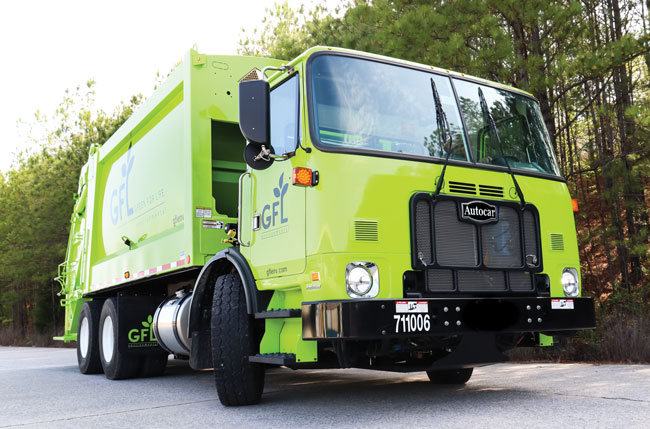Regular preventative maintenance and ensuring that your truck has a team of professionals ready to minimize any downtime for your trucks will help avoid major issues during the lifecycle of your refuse fleet.
By Timothy Thornton
Everyone is aware of the phrase “time is money.” When it comes to refuse truck fleet management, that statement is doubly true. A broken-down refuse truck not only costs money to fix, but it is also unable to service clients and generate revenue. Additionally, another truck must take its place to fulfill its obligations, further compounding the financial impact.
Maintaining electrical systems is a key part of any preventative maintenance regimen. The sheer amount of wiring in vehicles is increasing exponentially, and the number of systems impacted by vehicle electronics continues to expand with every new model year. Whether it is tire pressure monitoring, GPS navigation, cruise control, climate control, telematics or any of the systems controlling the mechanical components of refuse trucks, a lot of features rely on a well-maintained and functioning electrical system. In fact, electrical systems are the most common warranty item for many truck OEMs, with an overwhelming 70 percent of truck down situations classified as electrical failures.
Extent of Customization
The first factor fleet managers need to consider when planning for electrical system maintenance is the extent of customization their trucks have undergone. Body shops and truck converters often make modifications to a truck, slicing or tapping into existing wiring harnesses and creating potential vulnerabilities in the electrical system.
Look for an OEM that custom engineers severe-duty vocational trucks. These refuse trucks can then be engineered for the customer’s specific refuse body. It starts with engineering each truck for a specific customer’s needs and working closely with their selected body company’s engineers. All of the body components are then installed during the production process. So, all the electrical harnesses are installed together, eliminating the risk of splices, loose connectors or drilled access holes that could otherwise occur when the truck is at the body builder.
Routing and Clipping
Before committing to buy any refuse truck for their fleet, operators should note the level of detail when it comes to routing and clipping. Battery cables should be routed to minimize rubbing, making them easy to inspect. Routing away from the bottom frame rail should be used to prevent dirt build-up as well as use of water sealed connectors everywhere, even inside the cab, to help keep water and dirt out. Lastly, breathable harness coverings can help provide protection from water, rats, dirt and chemicals.

Corrosion and Parasitic Draws
When it comes to preventative maintenance for trucks already in the fleet, periodic scheduled inspections should look for any evidence of corrosion. Electrical wires constantly undergo a process of heating up and cooling down and attracting moisture, which can lead to corrosion. Parasitic draws are another source of concern for the health of electrical systems. A parasitic draw can leave an otherwise good truck stranded on the side of the road with little to no warning. Faulty switches, alternators and relays can all lead to a battery being drained.
Diagnosing Tools
Even with preventative maintenance, electrical system issues can still occur. When they do, being able to diagnose the problem quickly becomes the most pressing task. One touch diagnostic systems can significantly minimize downtime. The system provides electrical diagnostic/report of failed fuses or circuits to the operators and technicians and shows them how to fix it, complete with easy access to wiring schematics and 3D diagrams on display.
Another tool that can help find and diagnose problems in the electrical system is a smart fuse box. A smart fuse box communicates with the rest of the vehicle, monitoring fuses and relays. The smart fuse box can also detect parasitic draws in the systems that it monitors.
Lastly, minimizing downtime can be achieved by having a dependable OEM team behind every truck. Look for a partner that offers you the peace of mind of knowing that technicians are on call 24/7, always ready to provide over-the-phone assistance. In addition, a virtual tech service, available in an app, can give do-it-yourself instruction for repairing more minor issues and be a valuable tool in your arsenal.
Avoid Major Issues
While electrical system maintenance has always been a priority for refuse fleet owners and managers, rapid innovation in automotive technology will only bring about trucks with ever-increasing amounts of electrical systems. Limiting the need for retrofitting in the body-chassis integration process, regular preventative maintenance and ensuring that your truck has a team of professionals ready to minimize any downtime for your trucks will help avoid major issues during the lifecycle of your refuse fleet. | WA
Timothy Thornton is the Vice President and General Manager, Refuse for Autocar, LLC (Hagerstown, IN). As the only American-owned and operated OEM of trucks, Autocar’s severe-duty vocational trucks provide customers with the perfect tool for their jobs with the most uptime, support and impact on their bottom line. Autocar collaborates with customers to build trucks to their exact specifications and needs. Autocar recognizes that performance and uptime are
everything and offers every customer 24/7 access to its Always Up direct factory support center staffed by expert technicians who engineer and build Autocar’s trucks. Autocar promises to provide trucks that deliver the best value, provide the best service, provide a complete solution for customers’ needs, do the work right the first time and act proactively, timely and with simplicity. For more information, call (833) 857-0200 or visit AutocarTruck.com.
